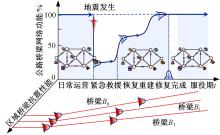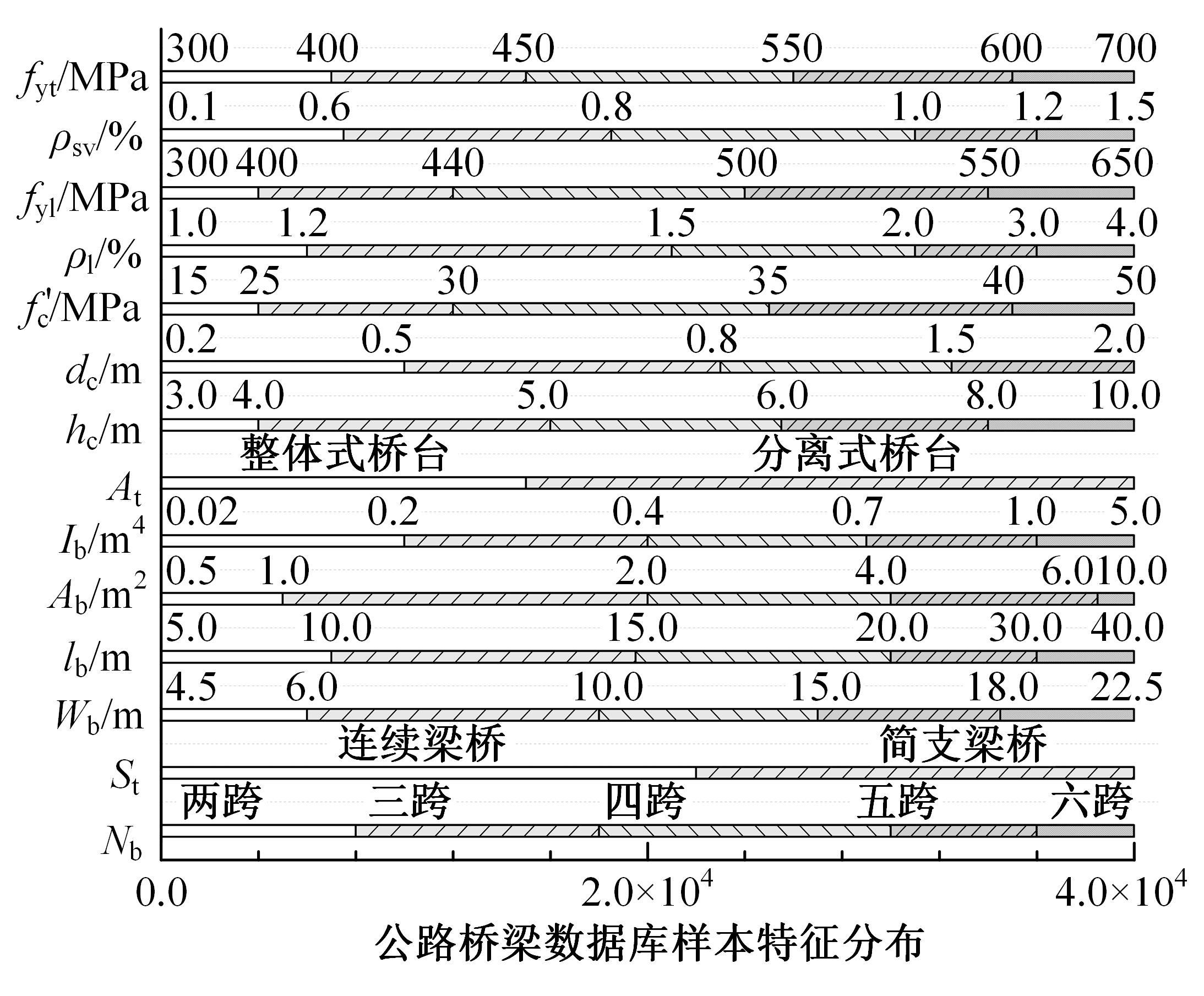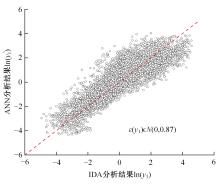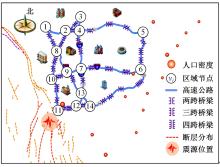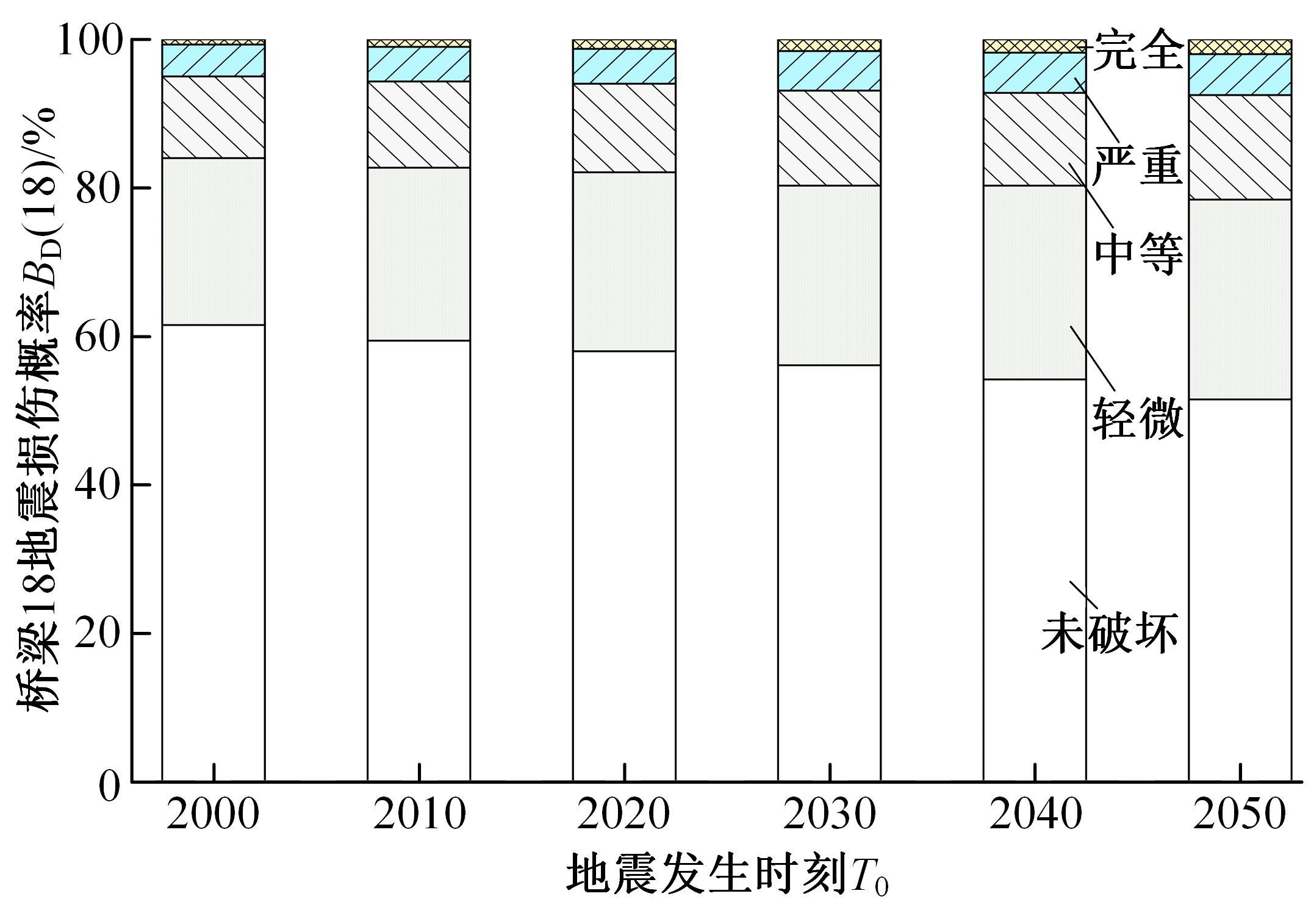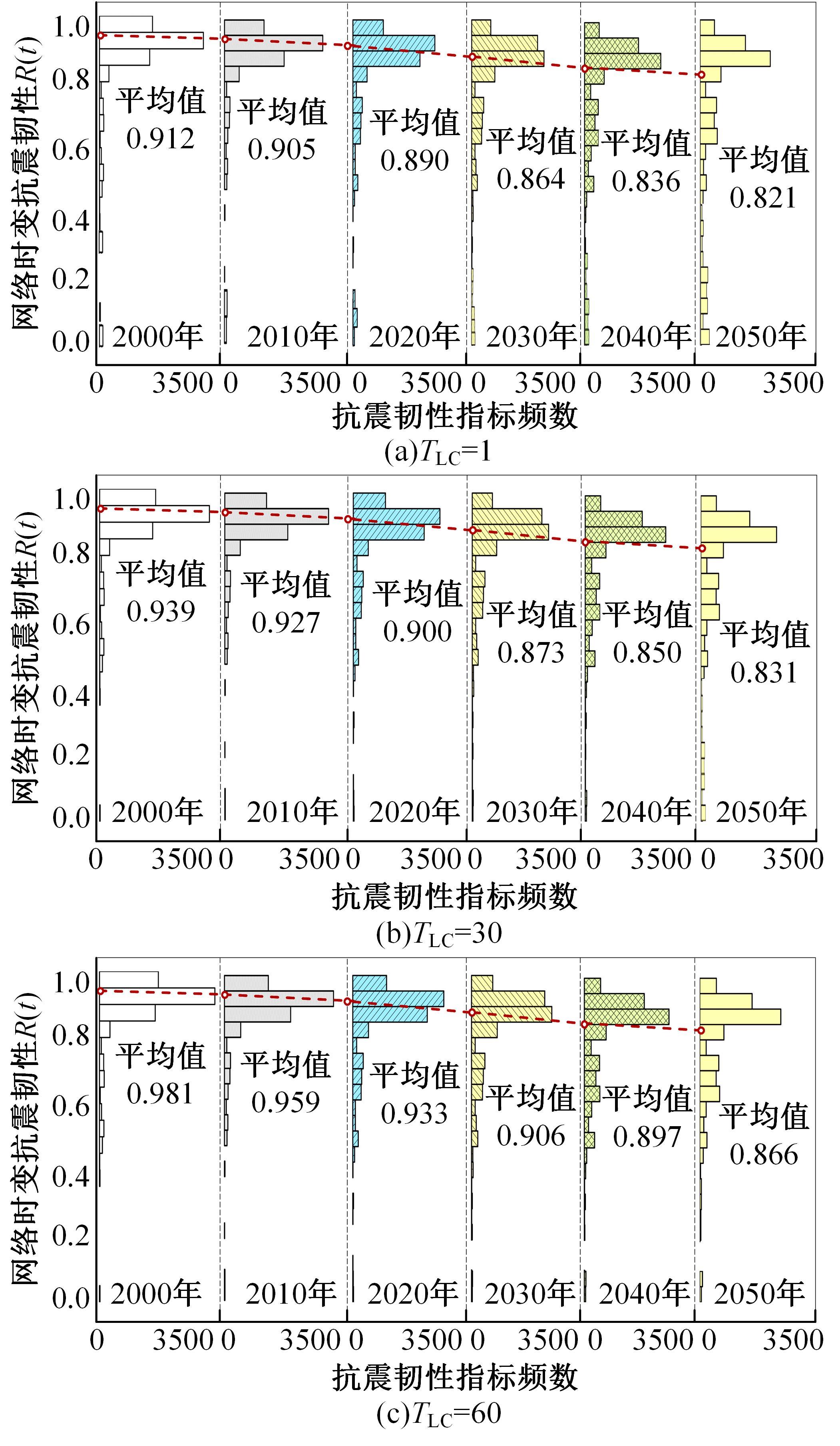Journal of Jilin University(Engineering and Technology Edition) ›› 2023, Vol. 53 ›› Issue (6): 1695-1701.doi: 10.13229/j.cnki.jdxbgxb.20221352
Life⁃cycle seismic resilience assessment of highway bridge networks using data⁃driven method
Zhen-liang LIU1,2( ),Cun-bao ZHAO1(
),Cun-bao ZHAO1( ),Yun-peng WU1,2,Mi-na MA1,2,Long-shuang MA1,2
),Yun-peng WU1,2,Mi-na MA1,2,Long-shuang MA1,2
- 1.School of Safety Engineering and Emergency Management,Shijiazhuang Tiedao University,Shijiazhuang 050043,China
2.Structure Health Monitoring and Control Institute,Shijiazhuang Tiedao University,Shijiazhuang 050043,China
CLC Number:
- U44
| 1 | Hosseini S, Barker K, Ramirez-Marquez J E. A review of definitions and measures of system resilience[J]. Reliability Engineering & System Safety, 2016, 145: 47-61. |
| 2 | Bruneau M, Reinhorn A. Exploring the concept of seismic resilience for acute care facilities[J]. Earthquake Spectra, 2007, 23(1): 41-62. |
| 3 | Liu Z, Li S, Zhao W, et al. Post-earthquake assessment model for highway bridge networks considering traffic congestion due to earthquake-induced bridge damage[J]. Engineering Structures, 2022, 262: No. 114395. |
| 4 | Ghosh J, Padgett J E. Probabilistic seismic loss assessment of aging bridges using a component-level cost estimation approach[J]. Earthquake Engineering & Structural Dynamics, 2011, 40(15): 1743-1761. |
| 5 | Akiyama M, Frangopol D M, Ishibashi H. Toward life-cycle reliability-, risk- and resilience-based design and assessment of bridges and bridge networks under independent and interacting hazards: emphasis on earthquake, tsunami and corrosion[J]. Structure and Infrastructure Engineering, 2020, 16(1): 26-50. |
| 6 | Xiong C, Huang J, Lu X. Framework for city-scale building seismic resilience simulation and repair scheduling with labor constraints driven by time-history analysis[J]. Computer-Aided Civil and Infrastructure Engineering, 2020, 35(4): 322-341. |
| 7 | Billah M, Alam M S. Seismic fragility assessment of highway bridges: a state-of-the-art review[J]. Structure and Infrastructure Engineering, 2015, 11(6): 804-832. |
| 8 | Jeon J, Mangalathu S, Song J, et al. Parameterized seismic fragility curves for curved multi-frame concrete box-girder bridges using bayesian parameter estimation[J]. Journal of Earthquake Engineering, 2019, 23(6): 954-979. |
| 9 | Nielson B G, DesRoches R. Seismic fragility methodology for highway bridges using a component level approach[J]. Earthquake Engineering & Structural Dynamics, 2007, 36(6): 823-839. |
| 10 | Salehi H, Burgueño R. Emerging artificial intelligence methods in structural engineering[J]. Engineering Structures, 2018, 171: 170-189. |
| 11 | Liu Z, Li S, Guo A, et al. Comprehensive functional resilience assessment methodology for bridge networks using data-driven fragility models[J]. Soil Dynamics and Earthquake Engineering, 2022, 159: No.107326. |
| 12 | Lu X, Xu Y, Tian Y, et al. A deep learning approach to rapid regional post-event seismic damage assessment using time-frequency distributions of ground motions[J]. Earthquake Engineering & Structural Dynamics, 2021, 50(6): 1612-1627. |
| 13 | Dong Y, Frangopol D M, Saydam D. Sustainability of highway bridge networks under seismic hazard[J]. Journal of Earthquake Engineering, 2014, 18(1): 41-66. |
| 14 | Liu Z, Sextos A, Guo A, et al. ANN-based rapid seismic fragility analysis for multi-span concrete bridges[J]. Structures, 2022, 41: 804-817. |
| 15 | 苑溦, 刘振亮, 宗莉娜, 等. 海洋环境下钢骨混凝土桥墩时变抗震性能分析[J]. 南京工业大学学报: 自然科学版, 2020, 42(3): 342-350. |
| Yuan Wei, Liu Zhen-liang, Zong Li-na, et al. Time-dependent seismic performance analysis of steel reinforced concrete bridge piers in the marine environment[J]. Journal of Natural Tech University (Natural Science Edition), 2020, 42(3): 342-350. | |
| 16 | Ghosh J, Padgett J E. Aging considerations in the development of time-dependent seismic fragility curves[J]. Journal of Structural Engineering, 2010, 136(12): 1497-1511. |
| 17 | Baker J W, Lin T, Shahi S K, et al. New ground motion selection procedures and selected motions for the PEER transportation research program[R]. Berkeley, CA: Pacific Earthquake Engineering Research Center, 2011. |
| 18 | Boore D M, Atkinson G M. Ground-motion prediction equations for the average horizontal component of PGA, PGV, and 5%-damped PSA at spectral periods between 0.01 s and 10.0 s[J]. Earthquake Spectra, 2008, 24(1):99-138. |
| 19 | Chen M D, Mangalathu S, Jeon J S. Seismic reliability assessment of bridge networks considering travel time and connectivity reliabilities[J]. Earthquake Engineering & Structural Dynamics, 2022: 51(13): 3097-3110. |
| [1] | Dian-hai WANG,You-wei HU,Zheng-yi CAI,Jia-qi ZENG,Wen-bin YAO. Dynamic road resistance model of intermittent flow on urban roads based on BPR function [J]. Journal of Jilin University(Engineering and Technology Edition), 2023, 53(7): 1951-1961. |
| [2] | Zhuang-lin MA,Shan-shan CUI,Da-wei HU,Jin WANG. Travel mode choice of traditional car travelers after implementation of driving restriction policy [J]. Journal of Jilin University(Engineering and Technology Edition), 2023, 53(7): 1981-1993. |
| [3] | Wei-tiao WU,Kun ZENG,Wei ZHOU,Peng LI,Wen-zhou JIN. Deep learning method for bus passenger flow prediction based on multi-source data and surrogate-based optimization [J]. Journal of Jilin University(Engineering and Technology Edition), 2023, 53(7): 2001-2015. |
| [4] | Liu YANG,Chuang-ye WANG,Meng-yan WANG,Yang CHENG. Traffic flow characteristics of six⁃lane freeways with a dedicated lane for automatic cars [J]. Journal of Jilin University(Engineering and Technology Edition), 2023, 53(7): 2043-2052. |
| [5] | Guo-zhu CHENG,Lin SHENG,Hao ZHAO,Tian-jun FENG. Exclusive phase setting condition of signalized intersection based on risk analysis [J]. Journal of Jilin University(Engineering and Technology Edition), 2023, 53(7): 1962-1969. |
| [6] | Chao-ying YIN,Ying LU,Chun-fu SHAO,Jian-xiao MA,De-jie XU. Impacts of built environment on commuting mode choice considering spatial autocorrelation [J]. Journal of Jilin University(Engineering and Technology Edition), 2023, 53(7): 1994-2000. |
| [7] | Ya-li ZHANG,Rui FU,Wei YUAN,Ying-shi GUO. Classification and recognition model of entering and leaving stops' driving style considering energy consumption [J]. Journal of Jilin University(Engineering and Technology Edition), 2023, 53(7): 2029-2042. |
| [8] | Heng-yan PAN,Yong-gang WANG,De-lin LI,Jun-xian CHEN,Jie SONG,Yu-quan YANG. Evaluating and forecasting rear⁃end collision risk of long longitudinal gradient roadway via traffic conflict [J]. Journal of Jilin University(Engineering and Technology Edition), 2023, 53(5): 1355-1363. |
| [9] | Hong-fei JIA,Ying-jun XU,Li-li YANG,Nan WANG. League member selection and benefit distribution of commercial vehicles multi⁃modal transportation [J]. Journal of Jilin University(Engineering and Technology Edition), 2023, 53(4): 1060-1069. |
| [10] | Yu-lin CHANG,Wen-qian XU,Chao SUN,Peng ZHANG. Day⁃to⁃day equilibrium of hybrid traffic considering obedience degree under internet of vehicles environment [J]. Journal of Jilin University(Engineering and Technology Edition), 2023, 53(4): 1085-1093. |
| [11] | Chao SUN,Hao-wei YIN,Wen-yun TANG,Zhao-ming CHU. Sensor deployment strategy and expansion inference of mobile phone data for traffic demand estimation [J]. Journal of Jilin University(Engineering and Technology Edition), 2023, 53(4): 1070-1077. |
| [12] | Kai LU,Guang-hui XU,Zhi-hong YE,Yong-jie LIN. Algebraic method of bidirectional green wave coordination control for the head of the platoon considering the clearance time [J]. Journal of Jilin University(Engineering and Technology Edition), 2023, 53(2): 421-429. |
| [13] | Heng-yan PAN,Wen-hui ZHANG,Ting-ting LIANG,Zhi-peng PENG,Wei GAO,Yong-gang WANG. Inducement analysis of taxi drivers' traffic accidents based on MIMIC and machine learning [J]. Journal of Jilin University(Engineering and Technology Edition), 2023, 53(2): 457-467. |
| [14] | Bao-feng SUN,Tian-zi YAO,Yu-qi CHEN. Electric delivery vehicle routing problem optimization model with time⁃varying traffic congestion [J]. Journal of Jilin University(Engineering and Technology Edition), 2023, 53(2): 468-479. |
| [15] | Rui-fa LUO,Hui-jun HAO,Tao-rang XU,Qiu-fan GU. Fundamental diagram model of mixed traffic flow of connected and automated vehicles considering vehicles degradations and platooning intensity [J]. Journal of Jilin University(Engineering and Technology Edition), 2023, 53(2): 405-412. |
|
||


